Sinclair’s unique figurine was probably one of the finest renditions of the tyrant lizard king a child could ever hope to own in 1964, and remains a delightful piece of vintage memorabilia to this day.
In 1933, in conjunction with the Chicago World’s Fair, Sinclair Oil company commissioned an exhibit of life-sized dinosaur models for display. Built with rubbery skin over mechanical moving parts and cement and steel skeletons, the exhibit was a sensation, making many headlines and enamoring audiences. Thirty years later in 1964, Sinclair would once again sponsor the World’s Fair, now presented in New York City, with a prehistoric life exhibit even more grandiose than the first. Sinclair’s Dinoland exhibit featured nine life-sized dinosaur models, now built from fiberglass and once again equipped with animatronics. To further promote the exhibit, Sinclair produced a variety of merchandise to sell at the fair or in their own gas stations, including books, stickers, and plastic toys – in addition to the famous hollow “Mold-a-Rama” models, six smaller figurines were produced and sold as bagged sets. Although similar in some ways to the famous Marx toy line, which had been active for nearly a decade already, Sinclair’s figurines were entirely unique in design, and have earned special status of their own over the decades as vintage dinosaur collectibles.
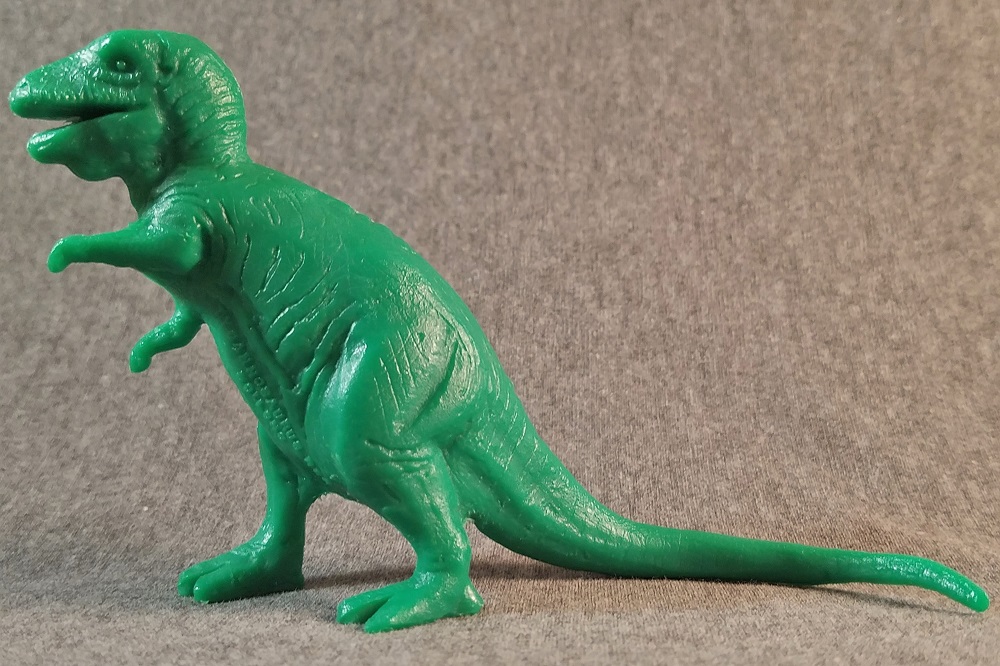
Of the nine dinosaur models produced for Dinoland – L. Paul Jonas designed the sculptures, with Barnum Brown and John Ostrom providing supervision – six of the genera were large herbivores, with the remaining three representing theropods and carnivores. The most prominent of these latter three was none other than Tyrannosaurus, the most iconic giant predator in the history of paleontology. Naturally, Tyrannosaurus also featured in much of the Dinoland merchandise, including the six-piece bagged plastic toy set, which sold in gas stations for years after Dinoland itself was dismantled.
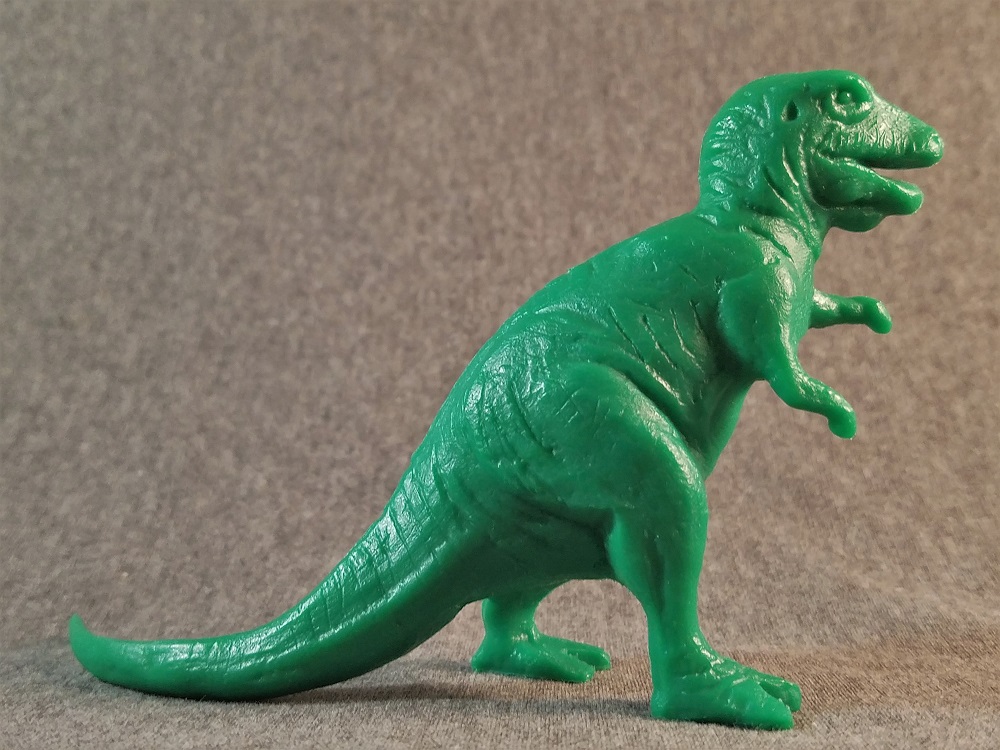
Measuring just over 8 cm (3.25 inches) tall and about 17.5 cm (7 inches) long with the curvature of the tail, the Sinclair Tyrannosaurus is the second largest figure in the set – more massive than the Trachodon and outmatched only by the Brontosaurus. The figure is posed walking in the classic upright stance, its slender tail dragging along the ground, with diminutive arms raised as if reaching to pursue a prey animal. The figure’s beady eyes and parted jaws also add to the personality, suggesting a creature of hungry intent held back by its own lumbering size. Wrinkles and folds of skin are cut and shaped into the figure’s sculpt, primarily around the neck and hips; pronounced muscles can also be seen bulging from the thighs and even hiding just under the skin of the shoulders and arms. Despite the figure’s small stature, the sheer mass of the living creature is excellently portrayed.

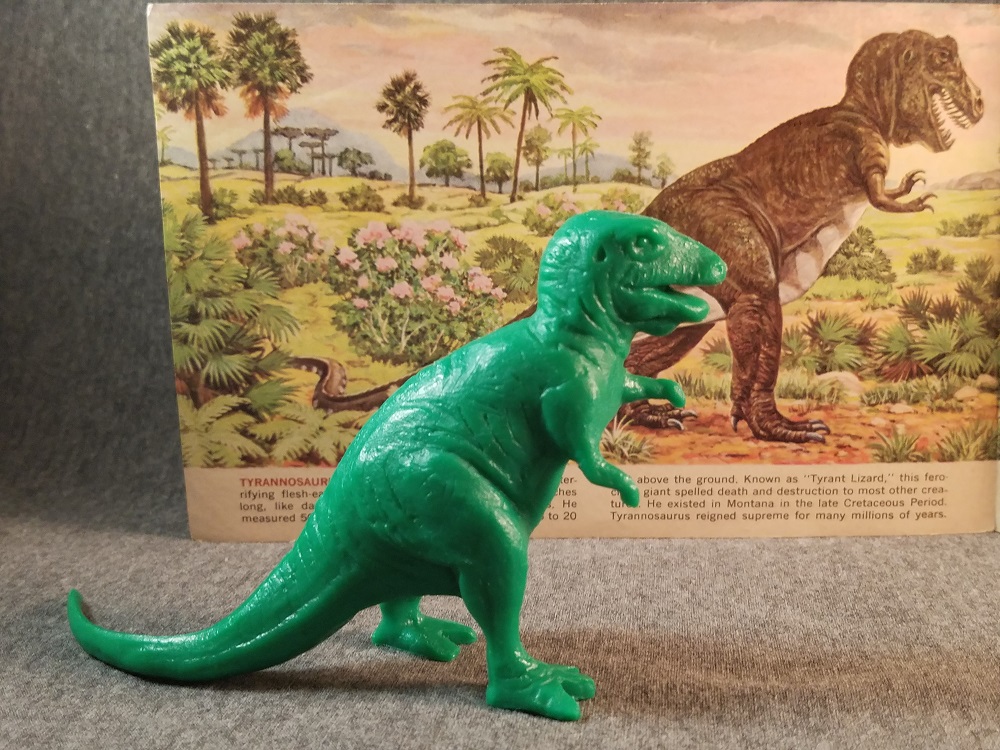
When designing the life-sized models for Dinoland, L. Paul Jonas referenced the seminal artwork of Charles R. Knight for the animals’ likeness; Knight’s influence can certainly be seen in the toy version of Tyrannosaurus, which bears heavy resemblance to Knight’s famous 1906 painting. However, the Sinclair figure appears to have a slightly thicker torso, plus a shorter neck and longer, narrower snout. The figure also lacks the brow and nasal ridges seen on the full-scale Dinoland sculpture, bearing a smoother facial appearance overall. Personally, I think the figure ends up most resembling the Tyrannosaurus seen in 1933’s King Kong – another iconic T. rex depiction, but one that was already decades old by the World’s Fair. While Sinclair intended Dinoland to be educational as well as entertaining, it’s a little hard to tell how much updated science trickled down to the toys. The Tyrannosaurus figure does seem to position the eye more appropriately far back on the skull (a mistake Knight himself made in early art), but as already mentioned, the rest of the skull is somewhat lacking in definition. To be fair, however, apart from the skull shape not much of Tyrannosaurus’s anatomy would be dramatically revised until after the end of the decade, so for the most part one could say the figure holds up for its time.

The figure does appear generous in depicting the length of Tyrannosaurus’ arms – which, although still small here, would have been even shorter proportionally in real life. The hands are small enough that it’s hard to distinguish whether the figure is meant to have three fingers or two. The feet are a bit crudely sculpted (true to most of the Sinclair figures), but there are obviously three large toes in front with a vestigial toe sticking backwards like a bird. Ear holes and nostrils are included on the head sculpt, in what looks like about the right places. And of particular interest is the absence of teeth or presence of lips. Whether or not dinosaurs had lips to sheath their teeth has become hotly debated in more recent years, with tyrannosaurs usually ending up front and center on the argument. Whether the toy sculptor meant to imply lips or simply skimped on dentary details, I can only guess, but it’s an unorthodox choice, even for the time when so many tyrant lizard figures were already baring their teeth.
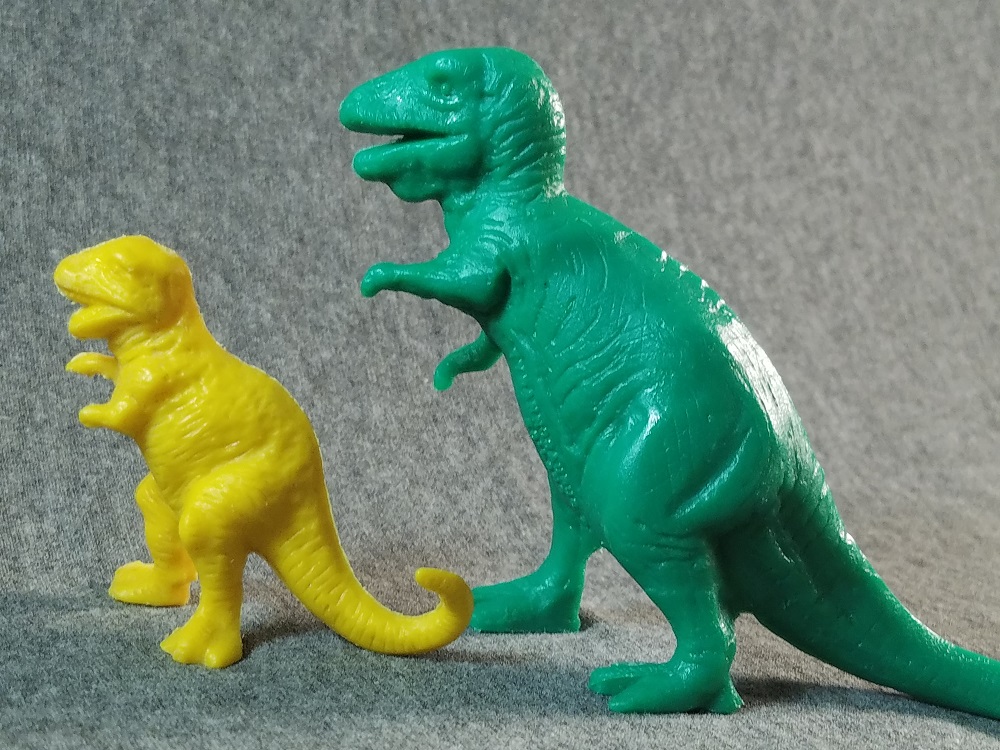
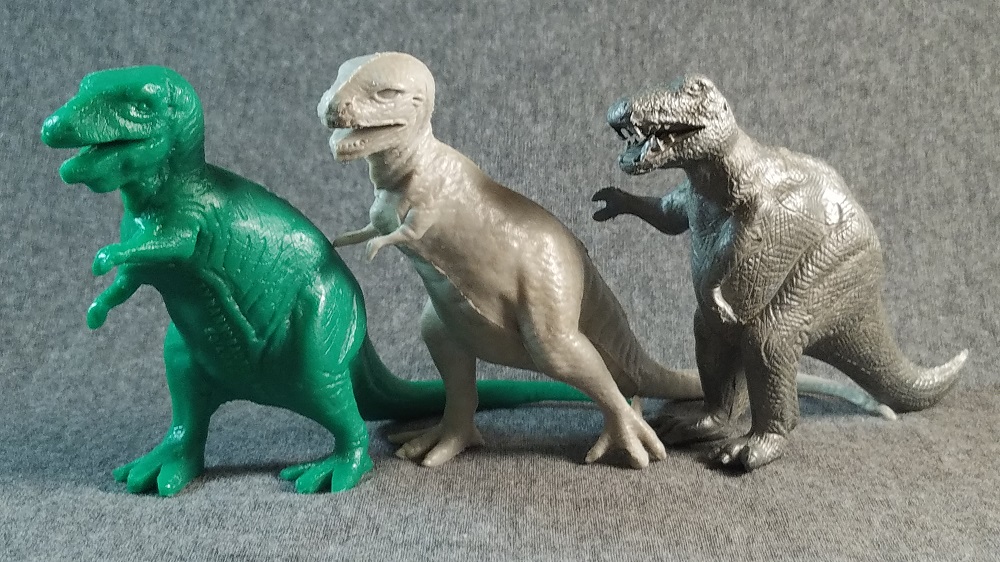
The figure is molded in bright, artificial green plastic, with engravings of the animal’s scientific name (both genus and species) and estimated length (50 ft – a big fella) printed on the left side of the belly. During the 1980s, the Sinclair molds were acquired by Dimensions For Children, who recasted the figures alongside similarly acquired figures from other brands for new playsets. While distinguishing original Sinclairs from DFC recasts can prove difficult sometimes, in the case of Tyrannosaurus, the process is a little easier. Unlike most of the Sinclair figures, which could be found in at least a couple of different colors, originals of Tyrannosaurus are consistently known to come in the bright green pictured here. Recasts come in other, more varied colors, likely with a different plastic quality; and more tellingly, recasts often lack the name and length engravings entirely.
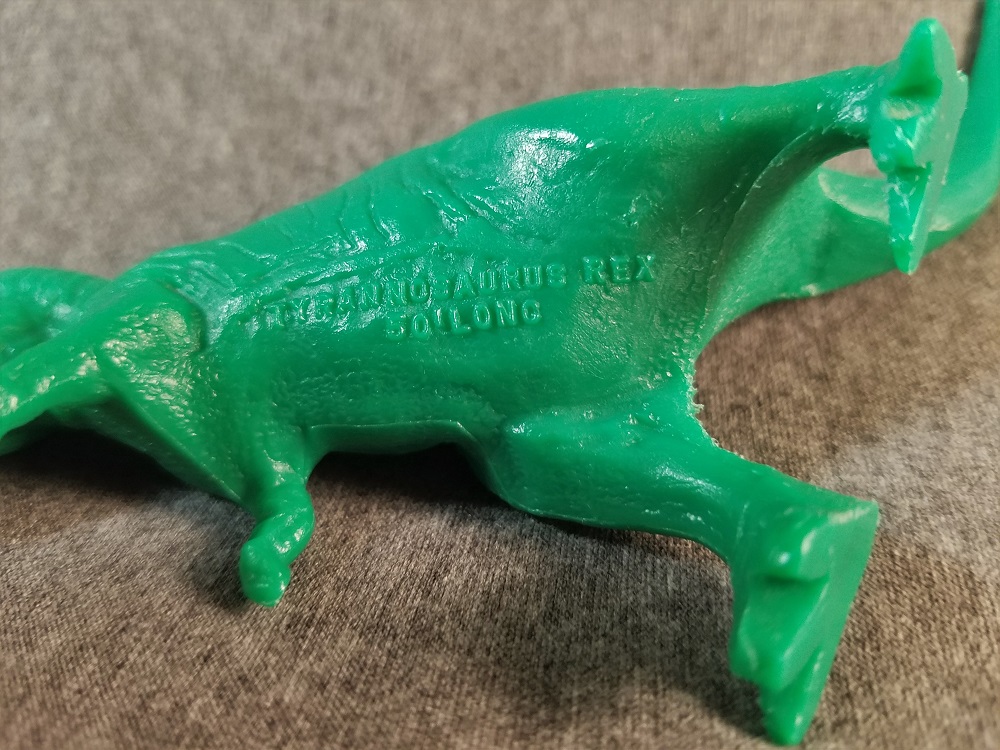
I must admit, Tyrannosaurus hasn’t been a true favorite dinosaur of mine in a long time, but lately I’ve been developing a much softer spot for retro Rex and its ilk. Sinclair’s toy Tyrannosaurus doesn’t quite capture the likeness of the life-size model it was meant to emulate, but on its own it’s still a delightfully charismatic piece of vintage dino merchandise. This figurine was probably one of the finest renditions of the tyrant lizard king a child could ever hope to own before Invicta and Safari Ltd. started changing the field forever; even now the Sinclair figure should have no trouble charming its way into a collector’s list of favorites. Sinclair toys don’t come often or easily these days, but keep your eyes peeled on eBay and eCrater. You never know when one of these figurines will rear its head in a listing!
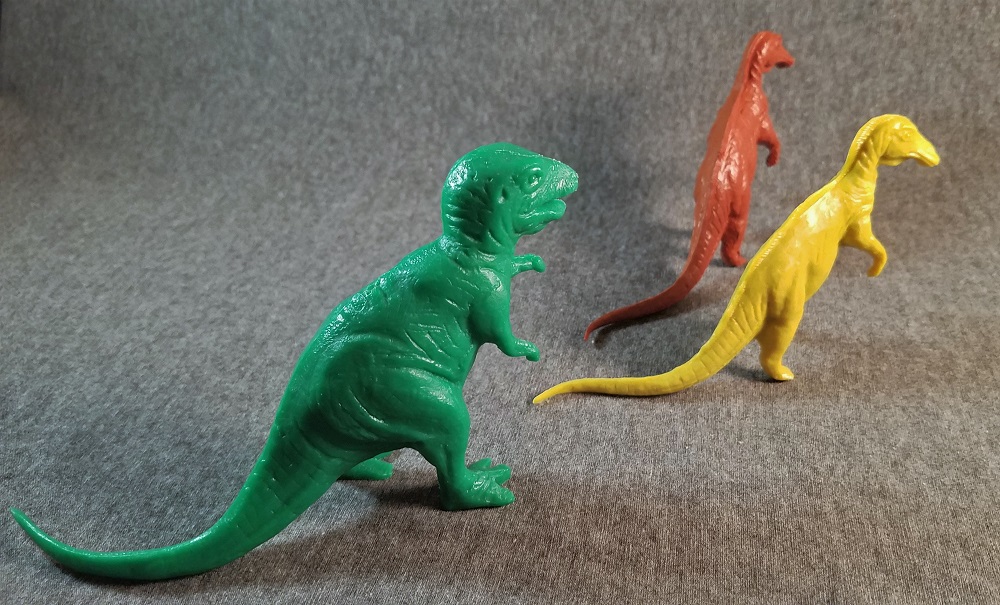
Support the Dinosaur Toy Blog by making dino-purchases through these links to Ebay and Amazon. Disclaimer: links to Ebay.com and Amazon.com on the The Dinosaur Toy Blog are often affiliate links, when you make purchases through these links we may make a commission

You mentioned “recasts”- I assume you mean those from the early 89s DFC (Dimensions For Children) set but those recast are not actually from the Sinclair set BUT the 1969/1970 NYC American Museum of Natural History Centennial set. This set was based on the Sinclair set (perhaps by modifying the original molds?) but besides the removal of SOME names the most glaring difference is that that AMNH T rex AND the DFC T rex BOTH HAVE TEETH. The original Sinclair has no teeth. The AMNH set was made in marbled copper plastic & was only available for sale during that short period and this a very rare.
That’s fascinating! This is the first I’ve heard of such a Centennial set. I’ve seen a few photos of the toothed recasts, but information regarding their history seems scarce so far. Thanks for the input!
Thanks!
A fully-toothed T rex replaced the toothless one at the fair as well. The fully-toothed version lacked the name of the animal on its body. All it appears were also recast in 1981 by Dimesions for Children, but I do not know how to tell the difference between the originals and the recasts, except that the NY World’s Fair T rexs (both versions) were only done in green.
A very good review as always, thanks. As for the teeth of the TRex it was reissued and teeth were added to the mould . I have both and can send pictures if you wish.
I would say that I like this one better than either Marx, but I can’t look past its missing teeth. It looks like this T. rex would have to gum its prey to death, which isn’t really intimidating. Great review, as usual. You must me almost done with these Sinclair reviews.
Thanks! Yes, just the Brontosaurus is left, and that review is ready to go. I really like these vintage toys, so it’s been fun covering them with the help of more knowledgeable folks in the community.